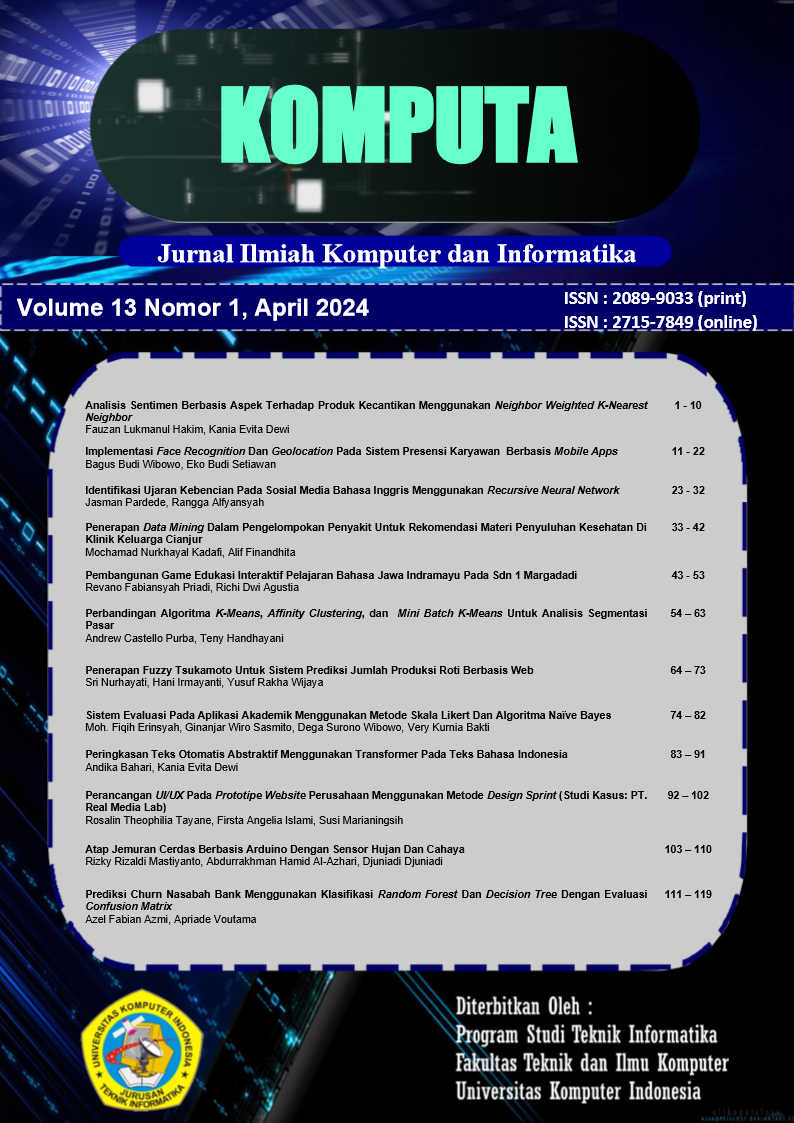Prediksi Churn Nasabah Bank Menggunakan Klasifikasi Random Forest Dan Decision Tree Dengan Evaluasi Confusion Matrix
Main Article Content
Abstract
Dalam lanskap perbankan yang terus berkembang, customer churn menjadi tantangan yang signifikan, yang berdampak pada pendapatan dan reputasi. Penelitian ini mengeksplorasi efektivitas pengklasifikasi Random Forest dan Decision Tree dalam memprediksi churn bank. Memanfaatkan dataset yang bersumber dari Kaggle, yang berisi informasi mengenai 10.000 nasabah bank, penelitian ini menggunakan teknik preprocessing dan pemilihan fitur untuk menyaring data. Selanjutnya, dataset tersebut dibagi menjadi set pelatihan dan pengujian untuk evaluasi model. Model Random Forest dan Decision Tree dilatih dan dievaluasi menggunakan analisis Confusion matrix. Hasilnya menunjukkan bahwa Random Forest mengungguli Decision Tree, mencapai rata-rata precision yang lebih tinggi (79% vs 72%), recall (78% vs 72%), F1-score (78% vs 72%), dan accuracy (78% vs 72%). Penelitian ini menyoroti keampuhan Random Forest dalam memprediksi churn nasabah secara akurat, sehingga memberikan wawasan yang berharga bagi bank dalam menerapkan strategi retensi nasabah yang efektif. Penelitian ini berkontribusi dalam memajukan analisis prediktif di sektor perbankan, memberdayakan institusi untuk mengurangi churn dan meningkatkan kepuasan pelanggan.
Article Details
Section
Penulis yang menerbitkan dengan jurnal ini setuju pada persyaratan berikut ini:
- Penulis menyimpan hak cipta dan memberikan jurnal hak penerbitan pertama, dengan pekerjaan 6 bulan setelah penerbitan secara simultan dengan lisensi di bawah: Creative Commons Attribution License yang memudahkan yang lain untuk berbagi karya dengan pengakuan penerbitan awal dan kepenulisan karya di jurnal ini.
- Penulis bisa memasukkan ke dalam penyusunan kontraktual tambahan terpisah untuk distribusi non-ekslusif versi kaya terbitan jurnal (contoh: mempostingnya ke repositori institusional atau menerbitkannya dalam sebuah buku), dengan pengakuan penerbitan awalnya di jurnal ini.
- Penulis diizinkan dan didorong untuk mem-posting karya mereka online (contoh: di repositori institusional atau di website mereka) sebelum dan selama proses penyerahan, karena dapat mengarahkan ke pertukaran produktif, seperti halnya sitiran yang lebih awal dan lebih hebat dari karya yang diterbitkan. (Lihat Efek Akses Terbuka).
How to Cite
References
DAFTAR PUSTAKA
Miryam Clementine and Arum, “Prediksi Churn Nasabah Bank Menggunakan Klasifikasi Naïve Bayes dan ID3,” Jurnal Processor, vol. 17, no. 1, pp. 9–18, May 2022, doi: 10.33998/processor.2022.17.1.1170.
M. Kaur, K. Singh, and N. Sharma, “International Journal on Recent and Innovation Trends in Computing and Communication Data Mining as a tool to Predict the Churn Behaviour among Indian bank customers”, [Online]. Available: http://www.ijritcc.org
H. Guliyev and F. Yerdelen Tatoğlu, “Customer churn analysis in banking sector: Evidence from explainable machine learning models,” Journal of Applied Microeconometrics, vol. 1, no. 2, pp. 85–99, Dec. 2021, doi: 10.53753/jame.1.2.03.
F. R. Lumbanraja, W. Mudyaningsih, B. Hermanto3, and A. Syarif, “IMPLEMENTASI METODE RANDOM FOREST UNTUK PREDIKSI POSISI METILASI PADA SEKUENS PROTEIN.”
M. A. Hambali and I. Andrew, “Bank Customer Churn Prediction Using SMOTE: A Comparative Analysis,” Qeios, Mar. 2024, doi: 10.32388/H82XTW.
Y. Y. Song and Y. Lu, “Decision tree methods: applications for classification and prediction,” Shanghai Arch Psychiatry, vol. 27, no. 2, pp. 130–135, Apr. 2015, doi: 10.11919/j.issn.1002-0829.215044.
B. Charbuty and A. Abdulazeez, “Classification Based on Decision Tree Algorithm for Machine Learning,” Journal of Applied Science and Technology Trends, vol. 2, no. 01, pp. 20–28, Mar. 2021, doi: 10.38094/jastt20165.
M. Rahman and V. Kumar, “Machine Learning Based Customer Churn Prediction in Banking,” in Proceedings of the 4th International Conference on Electronics, Communication and Aerospace Technology, ICECA 2020, Institute of Electrical and Electronics Engineers Inc., Nov. 2020, pp. 1196–1201. doi: 10.1109/ICECA49313.2020.9297529.
C. Chen and A. Liaw, “Using Random Forest to Learn Imbalanced Data.”
M. Ohsaki, P. Wang, K. Matsuda, S. Katagiri, H. Watanabe, and A. Ralescu, “Confusion-matrix-based kernel logistic regression for imbalanced data classification,” IEEE Trans Knowl Data Eng, vol. 29, no. 9, pp. 1806–1819, Sep. 2017, doi: 10.1109/TKDE.2017.2682249.
F. Agung, J. Ayomi, and K. E. Dewi, “ANALISIS EMOSI PADA MEDIA SOSIAL TWITTER MENGGUNAKAN METODE MULTINOMIAL NAÏVE BAYES DAN SYNTHETIC MINORITY OVERSAMPLING TECHNIQUE,” KOMPUTA : Jurnal Ilmiah Komputer dan Informatika, vol. 12, no. 2, 2023, [Online]. Available: https://www.statista.com
D. AL-Najjar, N. Al-Rousan, and H. AL-Najjar, “Machine Learning to Develop Credit Card Customer Churn Prediction,” Journal of Theoretical and Applied Electronic Commerce Research, vol. 17, no. 4, pp. 1529–1542, Dec. 2022, doi: 10.3390/jtaer17040077.
M. Zheng, “Customer Churn Prediction based on Multiple Algorithms,” Scientific Journal of Economics and Management Research, vol. 2, p. 2020.
S. D. Oleh and A. Allaam, “Prediksi Churn Konsumen Menggunakan Algoritma Random Forest dengan Fuzzy C-Means untuk Meningkatkan Produktivitas Penjualan Bisnis,” 2023.
P. Verma, “Churn prediction for savings bank customers: A machine learning approach,” J Stat Appl Probab, vol. 9, no. 3, pp. 535–547, 2020, doi: 10.18576/JSAP/090310.

